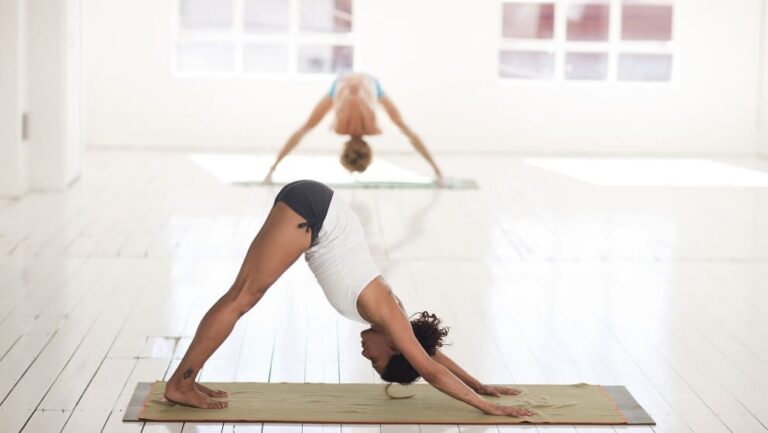In this 8th article, we continue along the journey of sun salutations and explore the next movement – the transition from upward facing dog to downward facing dog.
https://www.yoganatomy.com/up-dog-to-down-dog-sun-salutations/ – David Keil
In our last article on Sun Salutations, we discussed the transition from chaturanga into upward facing dog. We continue here by talking about the transition from upward facing dog to downward facing dog.
It seems simple enough, but how we move and where we move from is important. As we’ve discussed in other articles, we are always using existing patterns, consciously or unconsciously. Every time we move, we have an opportunity to create more refined or healthier patterns. This typically requires a conscious decision to move in a particular way. I’m sure you’ve all run into a teacher who has asked you to do a posture or transition in a different way than you typically do it and you’ve become aware of the conscious effort required to do so.
Let’s tie in to where we left off in upward facing dog. Personally, I prefer to give a light press into my mat through my feet. I find that pressing down through the tops of the feet has the effect of lifting the rest of my body away from the floor. This is especially true when I am also pressing down firmly through my hands as we discussed in Sun Salutations 7.
The foot doesn’t press itself though, does it? It’s at the end of a chain of joints we call the leg. If the leg is straight, the pressing action of the foot into the floor actually comes from the hip joint. Even though the hip joint is technically in extension, it is flexing just enough that the foot is pressed into the floor. What is the strongest hip flexor? tic, toc, tic, toc. THE PSOAS!
I know it seems counterintuitive to be flexing the hip joint, but it’s really just adding the intention of flexing. It’s slight. Because I am already in an extended position at the hip joint, the small amount of energy put into flexion doesn’t flex the hip joint, it stabilizes it. From that foundation I can then focus on working with my spine. It’s not a right or wrong, just the way I like to use my anatomy.
Using The Psoas To Transition From Upward Facing Dog
In the transition from up dog to down dog most of us will default to initiating movement from our toes, feet, or ankles. I have witnessed many varieties of this transition in the feet. Some are ugly, some are interesting, and some appear to work fine. What sometimes goes along with this toe/foot/ankle movement is that the knee bends, breaking the chain of joints and allowing an easier way to move from up dog to down dog. I’m not saying this as if it’s a bad thing. Beginners may need to do this. What I’m suggesting is that you explore and continue to refine the movement as you practice.
I often have a play with this in my yoga anatomy workshops. When we do our focused sun salutations using the psoas of the lower body, I make everyone lift their hips before doing anything at all with their feet. There is often a lot of grunting and groaning going on.
My interpretation of what I see in those workshops is that many students have not considered moving from their psoas as on the list of things to do when transitioning from upward facing dog to downward facing dog. Perhaps in my own experience, my psoas is primed by that small amount of engagement I give it during my upward facing dog. Perhaps it’s just that I’ve trained myself to do it.
Why You Should Focus On This
As I said above, patterns and how we focus, or don’t focus on them, are important parts of the practice. In the big picture, the physical patterns that we do should be driving us toward our core. Whenever we can make movement come from the deeper more intrinsic movers of our body, we are doing that.
It is this driving movement into the deeper more intrinsic muscles that starts to clean up the patterns. It’s the way in which we refine movement. This is what people like Ida P. Rolf, Joseph Pilates, and others mean when they refer to moving from the core.
What’s most important about the core is that as you move from it, it naturally leads to refined movement.
How To Do This
This is a really simple technique to employ.
– While in up dog, have a play with pressing your feet into the floor. This is different than just engaging the muscles in your leg such as the quadriceps. Instead, imagine your leg as a single unit that you are pressing into the floor through your feet.
– Keep this action going and slowly turn up the volume. In other words, increase the force you are creating from the hip joint.
– Lead the movement with your hips going up first.
– DON’T flip your feet until your hips are as far as they can go.
– When you can do this, integrate your hips leading the movement and the feet flipping after your hips have gone high enough, but not necessarily as high as you can take them.
Then it integrates into one movement, with the hips leading (View the video here)

